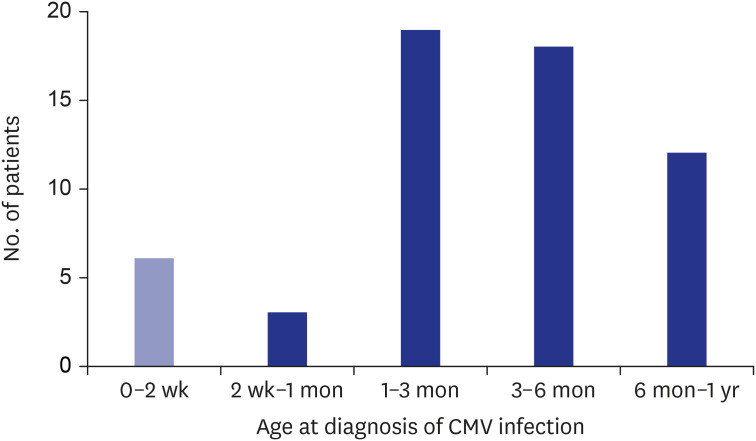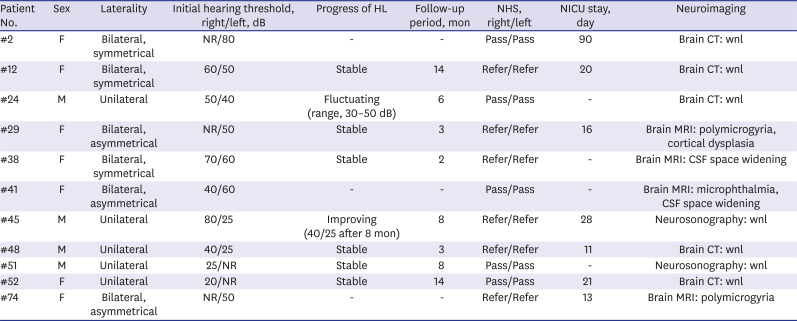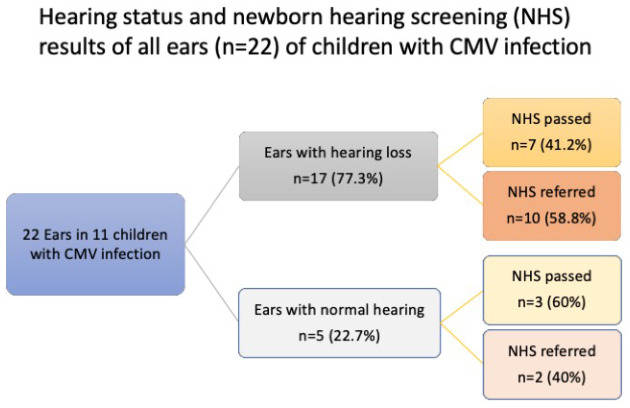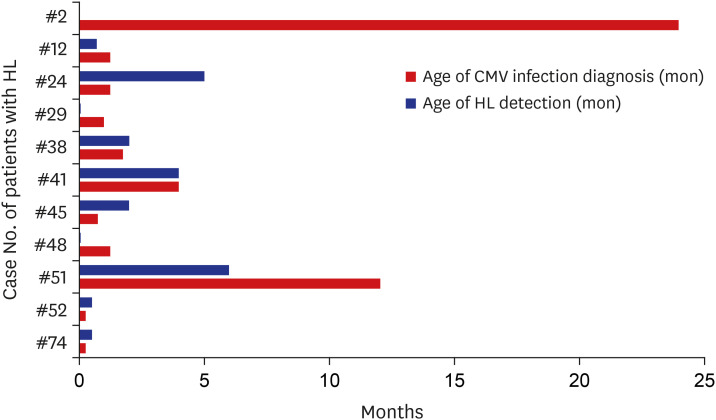1. Kenneson A, Cannon MJ. Review and meta-analysis of the epidemiology of congenital cytomegalovirus (CMV) infection. Rev Med Virol. 2007; 17(4):253–276. PMID:
17579921.

2. Dollard SC, Grosse SD, Ross DS. New estimates of the prevalence of neurological and sensory sequelae and mortality associated with congenital cytomegalovirus infection. Rev Med Virol. 2007; 17(5):355–363. PMID:
17542052.

3. Mestas E. Congenital cytomegalovirus. Adv Neonatal Care. 2016; 16(1):60–65. PMID:
26752783.

4. Fowler KB, Dahle AJ, Boppana SB, Pass RF. Newborn hearing screening: will children with hearing loss caused by congenital cytomegalovirus infection be missed? J Pediatr. 1999; 135(1):60–64. PMID:
10393605.

5. Fowler KB, McCollister FP, Sabo DL, Shoup AG, Owen KE, Woodruff JL, et al. A targeted approach for congenital cytomegalovirus screening within newborn hearing screening. Pediatrics. 2017; 139(2):e20162128. PMID:
28049114.

6. Goderis J, Keymeulen A, Smets K, Van Hoecke H, De Leenheer E, Boudewyns A, et al. Hearing in children with congenital cytomegalovirus infection: results of a longitudinal study. J Pediatr. 2016; 172:110–115.e2. PMID:
26858192.

7. Riga M, Korres G, Chouridis P, Naxakis S, Danielides V. Congenital cytomegalovirus infection inducing non-congenital sensorineural hearing loss during childhood; a systematic review. Int J Pediatr Otorhinolaryngol. 2018; 115:156–164. PMID:
30368378.

8. Manicklal S, Emery VC, Lazzarotto T, Boppana SB, Gupta RK. The “silent” global burden of congenital cytomegalovirus. Clin Microbiol Rev. 2013; 26(1):86–102. PMID:
23297260.

9. Watkin PM, Baldwin M. Identifying deafness in early childhood: requirements after the newborn hearing screen. Arch Dis Child. 2011; 96(1):62–66. PMID:
21047829.

10. Dobbie AM. Evaluation and management of cytomegalovirus-associated congenital hearing loss. Curr Opin Otolaryngol Head Neck Surg. 2017; 25(5):390–395. PMID:
28857892.

11. Foulon I, Naessens A, Faron G, Foulon W, Jansen AC, Gordts F. Hearing thresholds in children with a congenital CMV infection: a prospective study. Int J Pediatr Otorhinolaryngol. 2012; 76(5):712–717. PMID:
22386305.

12. Williamson WD, Demmler GJ, Percy AK, Catlin FI. Progressive hearing loss in infants with asymptomatic congenital cytomegalovirus infection. Pediatrics. 1992; 90(6):862–866. PMID:
1331946.
13. Dahle AJ, Fowler KB, Wright JD, Boppana SB, Britt WJ, Pass RF. Longitudinal investigation of hearing disorders in children with congenital cytomegalovirus. J Am Acad Audiol. 2000; 11(5):283–290. PMID:
10821506.
14. Madden C, Wiley S, Schleiss M, Benton C, Meinzen-Derr J, Greinwald J, et al. Audiometric, clinical and educational outcomes in a pediatric symptomatic congenital cytomegalovirus (CMV) population with sensorineural hearing loss. Int J Pediatr Otorhinolaryngol. 2005; 69(9):1191–1198. PMID:
16061110.

15. Sabroske E, Svoboda MD, Ng YT. Passing the newborn hearing screen does not always exclude acquired hearing loss due to congenital infection. Pediatr Neurol. 2018; 83:60–61. PMID:
29622487.

16. Haesen S, Shaw D. Clinical characteristics, audiological and neurodevelopmental outcomes of newborns with congenital cytomegalovirus infection. Swiss Med Wkly. 2018; 148:w14628. PMID:
29767827.

17. Seo S, Cho Y, Park J. Serologic screening of pregnant Korean women for primary human cytomegalovirus infection using IgG avidity test. Korean J Lab Med. 2009; 29(6):557–562. PMID:
20046088.

18. Sohn YM, Park KI, Lee C, Han DG, Lee WY. Congenital cytomegalovirus infection in Korean population with very high prevalence of maternal immunity. J Korean Med Sci. 1992; 7(1):47–51. PMID:
1329845.

19. Kim BJ, Han JJ, Shin SH, Kim HS, Yang HR, Choi EH, et al. Characterization of detailed audiological features of cytomegalovirus infection: a composite cohort study from groups with distinct demographics. BioMed Res Int. 2018; 2018:7087586. PMID:
30228987.

20. Ronchi A, Shimamura M, Malhotra PS, Sánchez PJ. Encouraging postnatal cytomegalovirus (CMV) screening: the time is NOW for universal screening! Expert Rev Anti Infect Ther. 2017; 15(5):417–419. PMID:
28277819.

21. Lu CY, Tsao PN, Ke YY, Lin YH, Lin YH, Hung CC, et al. Concurrent hearing, genetic, and cytomegalovirus screening in newborns, Taiwan. J Pediatr. 2018; 199:144–150.e1. PMID:
29681450.

22. Kim J, Lee YK, Ko SY, Shin SM. Diagnostic clues for congenital cytomegalovirus infection: association with newborn hearing screening tests. Neonatal Med. 2019; 26(2):96–101.

23. Vancor E, Shapiro ED, Loyal J. Results of a targeted screening program for congenital cytomegalovirus infection in infants who fail newborn hearing screening. J Pediatric Infect Dis Soc. 2019; 8(1):55–59. PMID:
29373759.

24. Kimberlin DW, Lin CY, Sánchez PJ, Demmler GJ, Dankner W, Shelton M, et al. Effect of ganciclovir therapy on hearing in symptomatic congenital cytomegalovirus disease involving the central nervous system: a randomized, controlled trial. J Pediatr. 2003; 143(1):16–25. PMID:
12915819.

25. Schleiss MR. Congenital cytomegalovirus infection: update on management strategies. Curr Treat Options Neurol. 2008; 10(3):186–192. PMID:
18579022.

26. Kimberlin DW, Jester PM, Sánchez PJ, Ahmed A, Arav-Boger R, Michaels MG, et al. Valganciclovir for symptomatic congenital cytomegalovirus disease. N Engl J Med. 2015; 372(10):933–943. PMID:
25738669.
27. McCrary H, Sheng X, Greene T, Park A. Long-term hearing outcomes of children with symptomatic congenital CMV treated with valganciclovir. Int J Pediatr Otorhinolaryngol. 2019; 118:124–127. PMID:
30611098.










 PDF
PDF Citation
Citation Print
Print





 XML Download
XML Download